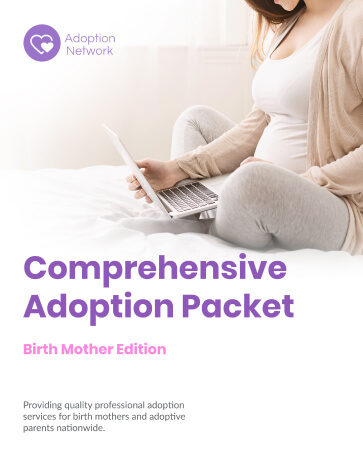
Planning for Labor and Delivery
If you have decided to place your baby for adoption, your needs and preparation can be slightly different when it comes to childbirth.
Preparing for Childbirth, Labor & Delivery
If you have decided to place your baby for adoption, your needs and preparation can be slightly different when it comes to childbirth. In addition to the information here, see this article by a Birth Mother on preparing for your hospital stay when you have an adoption plan.
As your due date approaches you will want to be prepared for the type of birth experience you wish to have. There are many factors to consider as you plan for the delivery day and the more familiar you are with your options, the easier it will be to create a birth plan.
Some things to think about are:
Where do you want to give birth? Who do you want there with you? Is there anything else that would make your birthing experience better?
Other considerations may include: what your insurance covers, if you have a high risk pregnancy, as well as where you live in proximity to hospitals or other birthing centers. For example, if you live in a very rural area, getting to a hospital 40 minutes away might not be an option for you so it will be good to come up with a plan for what you want this experience to look like. Below we will provide information about hospital births, birthing centers, home births, and water births for your consideration as your make your birth plan.
Hospital Birth
Almost all births take place in a hospital and many women prefer to be in the hospital to have access to the latest medical technology for their baby. Others choose the safety of a hospital because of a high-risk pregnancy, a vaginal birth after caesarean (VBAC) or the need for a C-section. You might also choose a hospital because that is where your doctor provides his or her services. In addition, many other medical interventions are available such as medications and fetal monitors. Make sure to take all of these factors into consideration when you are choosing which route you would like to take.
It’s also important to note that a hospital birth doesn’t have to feel cold and uninviting. Many hospitals have created rooms that look more like a soothing spa than a hospital. Further, some hospitals have an in-hospital birthing center where they offer natural childbirth as if you were at home. Then if the need arises, medical staff are just a few feet away.
Familiarize yourself with the hospital you are planning to give birth at and even see if you can take a tour if one is offered. Learn the rules and policies the hospital has to help you decide on your birth plan. Questions to ask are: Will you labor, deliver, and recover in the same room? Will it be a private room? Will your baby stay with you in your room or be in the nursery? Do you want to spend time alone with the baby or would you prefer the Adoptive Parents spend time with the baby?

Birth Center
Birth Centers (freestanding) have become more popular in recent years and these are a great alternative for women who don’t want to go to the hospital for labor and delivery but don’t feel comfortable with a home birth either.
Only healthy women with normal pregnancies should give birth in a birthing center as most are not prepared to handle medical emergencies that may occur with a high-risk pregnancy. Yet, they are affiliated with a hospital where you and your baby can be taken in an emergency, and most are covered by insurance. While they don’t have sophisticated medical equipment, they do have some provisions to monitor you and keep you as comfortable as possible. Often the birthing center is run by a midwife. A midwife has a nursing degree and has had 2 years of experience in labor and delivery.
As with a hospital birth, it is important to tour the facility before making a decision. Ask about the circumstances that might lead to a need to go to the hospital and make sure you are comfortable with the person who will be helping with the delivery. Not all states require licenses for midwives, so look into any other rules and policies you may have questions about for your specific state.
Home Birth
A home birth can provide the privacy and intimacy that some mothers desire. Although less than 1% of women choose a home birth, the numbers have risen in the last 10 years. However, it’s not without risks. The American College of Obstetricians and Gynecologists show that the risk (although low) of the infant dying is higher when the baby is born at home.
When speaking of a home birth, it is not something you do alone. You are assisted by a qualified health care provider or midwife. When giving birth at home, there is no need to tour the facility, but it is important that you interview your midwife and know her qualifications and feel comfortable with her. Ideally those who choose a home birth should be in good health, have a low-risk pregnancy, and have given birth previously. Research shows that women who choose to have their first child at home are more likely to have to go to the hospital because of complications.
Water Birth
Water births are typically done at home with a midwife, but some hospitals and birthing centers do offer water births. The purpose behind a water birth is to create a more soothing and relaxing laboring environment. A water birth does not affect the baby’s breathing because the baby doesn’t take a breath until it encounters air.
While you may seek advice from family, friends and doctors, you are the one to make the decision about where to give birth. Choose what you are comfortable with and what you feel is best for you and your baby. Be flexible—birth plans are not set in stone. Just know that if you have to change your birth plan to an environment you didn’t choose, it is for the health and safety of you and your baby.
When to go to the hospital or birth center:
Your doctor or midwife should have already talked to you about what to do when you go into labor, including when to call the office and when to head to the hospital or birth center. The general rule is to call when your contractions become steady at 5 minutes apart and they are strong enough that you are unable to speak through them. Most women have enough time to get to the hospital. Keep in mind, if your water breaks or you have vaginal bleeding more than light spotting, call your provider but don’t panic, having your water break does not mean your baby is coming immediately. This is also a good time to call someone to take you to the hospital.
Don’t worry if your doctor or midwife doesn’t tell you to come in right away. Some hospitals have policies about admittance and you don’t want to be turned away because you are not far enough along.
You don’t want to wait too long either because waiting may result in more medical intervention than you might have planned for the birth. If you have had any complications during your pregnancy, or you are less than 38 weeks along, your doctor may ask you to head to the hospital right away so you and the baby can start being monitored. Also, if you live far away from the hospital it is better to get there with plenty of time left rather than not enough.

What happens when you arrive at the hospital:
If your doctor hasn’t instructed you on where to go when you arrive at the hospital, go in the main entrance (this may be the emergency entrance if it’s after hours) and you will be directed to the maternity ward. Once there, find the nurse’s station and they will take it from there. You will have to fill out paperwork unless you had the option to register ahead of time and then paperwork will be minimal.
You will then be taken to an exam room or a birthing room depending how far into labor you are. The nurse will check your pulse, blood pressure, temperature and ask for a urine sample. A vaginal exam will be done to see how dilated you are. You will also be asked about your contractions, whether or not your water is broken, and about your health history.
At this point, generally you will either be admitted or sent home if it is false labor. When you are admitted, they will start monitoring the baby’s heart and the frequency and duration of your contractions. This is a good time to tell the nurse or midwife about your birth plan, if you have one, like if you want to use medication during your labor. You might have blood drawn to check for anemia or infection, and most hospitals will start an IV. Even if you have chosen a medication-free labor, an IV can keep you hydrated during labor since you cannot eat or drink while in labor.
What to Expect During Labor:
Here’s a brief overview of what to expect when labor starts.
The childbirth process is separated into three stages:
- First Stage – From the beginning of true labor until the cervix is completely dilated to 10cm
- Second Stage – After the cervix is dilated to 10cm until the baby is delivered (Pushing and Delivery)
- Third Stage – Delivery of the placenta
The First Stage of Labor
The first stage of labor has three phases. Early labor, active labor and transition labor. This first stage of labor is usually the longest, especially if you are a first time mom, and can last 8-10 hours.
Early labor is considered the time labor begins until the cervix is dilated to 3cm. During this time you will begin to have contractions. Contractions last less than a minute and the frequency will be irregular. Contractions start out mild, but will progressively get stronger and more frequent. Generally you don’t need to be at the hospital until your contractions are steady and 5 minutes apart.
When your active labor starts you should be at the hospital or well on your way. Your contractions are now about 3 minutes apart and they are much stronger and last longer. During this phase your cervix will dilate from 3cm to 7cm. This is the point where you may ask for pain medication, like an epidural, if you want it. Women who opt for a natural (medication-free) labor may find relaxation and pain-management exercises provide some relief at this stage.
The final phase of this stage is when you transition from the first stage of labor to the second stage of labor. This is the shortest, but most intense part of the first stage of labor. Your contractions are long and very strong now, with little reprieve in between. Your cervix will dilate from 8 to 10 cm and it’s almost time to push. The baby has descended into your pelvis and you will feel pressure and have the urge to push.
The Second Stage of Labor
Sometimes referred to as the “pushing stage,” this is the part of labor that begins when your cervix is dilated to 10 cm and ends with the delivery of your baby. When your provider has prepped you for delivery, you will be told when to begin pushing. You will work with your contractions to move the baby through the birth canal and down to your vaginal opening. Once the baby’s head is out, your provider will clear the baby’s mouth and nose and make sure the umbilical cord is out of the way. After positioning the shoulders for exit, the baby will be born in one or two more pushes.
The Third Stage of Labor
The third stage is delivering the placenta, or afterbirth. After giving birth, your uterus will start to contract again and become very firm. This is because your body is preparing to expel the placenta. This stage is not one that is painful or difficult in most cases. You may have torn or been cut in your perineum (the space between your vaginal opening and your anus) during delivery to make room for the baby to come out. If so, you will be sewn up. If you’ve had an epidural, it will be removed. Now it’s time to rest from your hard work!
Preparing for Labor & Delivery
Prior to labor and delivery, as your due date draws near you might want to prepare what to bring with you to the hospital or birth center you have chosen.
You will want to prepare yourself a bag to take with you while you labor so that you don’t have to go through the house at the last minute packing.
The Essentials:
- Underwear if you don’t like the ones the hospital provides
- Warm socks
- Comfortable sleepwear
- Shampoo, makeup, hairbrush, toothbrush, etc.
- Picture ID, Insurance, and paperwork, a birth plan/adoption plan if you have one
- Glasses
- Loose fitting outfit to wear home
The Extras:
- Your phone and charger—check with the hospital first, some do not allow cell phones or computers
- A small massage tool for your back
- Relaxing music
- Snacks
- Books
- Magazines
- Hard candy or Lollipops (you won’t be able to eat or drink during labor)
- Anything else that can make your stay more comfortable
- A momento for the baby to give to the Adoptive Parents
The hospital stay and preparing for childbirth, labor & delivery might seem like an overwhelming topic. Remember to reach out to your adoption professional for support and ask any questions you may have.
DOWNLOAD the full “Pregnancy & Adoption Planning Guide” here
Available 24/7 to Answer Your Adoption Questions


Search Adoption Network
Speak with a Specialist 1-800-367-2367
